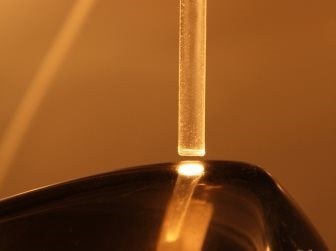

|
Edward Lowton
Editor |


|
Infrared emitter
18 September 2018
The new Spotlight infrared emitter from Heraeus Noblelight precisely targets a concentrated beam of infrared energy onto surfaces of of plastic components which offer difficult access to allow deburring, clenching or welding. As such, it is suitable for the automotive industry and for all industrial sectors where plastic components need to be further processed after moulding.

The emitter will be shown be shown for the first time at the Fakuma exhibition which takes place in October in Friedrichshafen, Germany.
The heat source of Spotlight consists of a shortwave, infra-red emitter with a QRC coating (Quartz Reflective Coating), which is connected to a quartz tube of just 5mm diameter. This tube functions as the guide for the infrared energy, which can then be focused precisely to the point where it is required. There is no need for lenses or complicated reflector systems or for the safety precautions required for lasers.
Energy is supplied at a power intensity of up to 500kW/m2 and the precise nature of the heating means that there is no thermal damage to the surrounding area, sensitive electronics or other nearby coated surfaces. Spotlight's fast response to on-off commands also fits it to robot-controlled plastics welding and finishing processes.
Spotlight is the latest addition to Heraeus' range of contour-matched QRC emitters.
These can be precisely shaped to the contours of a product, so that the heat is guided directly to edges, burrs or corners, making them ideal for deburring or welding of three-dimensional plastic products. Infra-red heat is applied precisely where required, in step with the process, so minimizing rejects, saving energy and costs and improving quality.
This Heraeus technology is already used throughout the industrial spectrum and, especially, in the automotive sector. Housing parts, covers, suction pipes or caps are often manufactured in plastic by injection moulding. During this manufacture, it is not always possible to prevent sharp edged burrs, especially in the tool parting plane. Especially with complex geometry parts, the removal of such burrs before subsequent processing or coating can be a real challenge.
Infrared emitters of quartz glass can be fashioned to match the edge or burr so that they exactly melt away the burr without damaging the actual workpiece itself. As such they are far superior to many conventional techniques, such as special blades or using gas flames, which often do not produce repeatable results and take time.
Using contact-free infra-red heating, plastic parts can be joined together without the need for adhesives or other means. In a very short time, the infrared radiation melts a thin surface layer of the individual plastic component. By simple compression this can then be joined with, say, containers for screen wash or brake fluid. In contrast to contact welding using hot plates, no plastic material adheres to the heat source and the heating stage is carried out at one second intervals and the result is repeatable every time.
Heraeus Noblelight offers the complete palette of infrared from near infra-red (NIR) to medium wave carbon technology (CIR). It also carries out tests with specific materials and advises on the choice of the emitter best suited to a specific process.
- Short wave system
- IR heater helps with hose fitting
- Lab relocates to Cambridge
- Warming role at chocolate maker
- Infra-red heating system
- Gas catalytic infrared oven installed for customer trials
- Spirit firm toasts new cask end process
- Electric and gas infrared solutions
- Infra-red heaters
- Gas catalytic ovens prove themselves fit for purpose

















